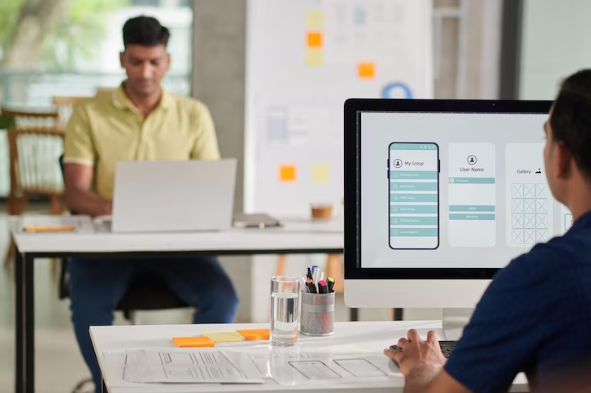Bringing a new tech product or service idea to life is exhilarating and intimidating. You have a vision in your head, but translating that into a concrete solution users can experience can feel overwhelming.
Where do you even begin materializing something from imagination into reality?
This is where prototyping comes in. Prototyping in MVP development is invaluable for tech startups ready to build their MVPs or established companies preparing to launch new offerings.
Creating prototypes early in development can transform nebulous concepts into tangible products that bring your vision to life.
In this post, we’ll explore how incorporating prototyping into your MVP process reduces risk, accelerates learning, and ultimately results in better solutions.
Let’s examine why every tech builder should embrace rapid prototyping!
Highlights of Contents
Defining the Role of Prototypes
A prototype is an experimental model of a new product or feature built to test ideas, assumptions, and concepts. Prototypes can take many forms, including:
- Wireframes outlining site/app structure
- Clickable mockups demonstrating user flow
- Limited functionality demos with simulated capabilities
- Minimalist versions focused on key features
The range of fidelity depends on the stage. Early prototypes may consist of rough sketches, while later ones can feel almost like finished products.
The connecting thread is quickly translating ideas into something stakeholders can experience hands-on. The act of prototyping prevents teams from operating in a silo.
Prototypes provide artifacts driving alignment by requiring developers, designers, and subject experts to collaborate closely.
This builds a shared understanding of what’s being built and why. So, in summary, the critical purpose of prototyping includes:
- Visualizing concepts
- Testing usability
- Demonstrating workflows
- Gathering user feedback
- Accelerating learning
- Reducing risk
Prototyping Powers MVP Creation
Now, let’s look at why this matters in constructing your MVP.
The MVP or “minimum viable product” approach is essential for startups. Building the most stripped-down version of your product containing only core features allows you to validate your hypotheses quickly with actual users.
But how do you build the “right” MVP to start? Prototyping is the secret weapon.
Rather than meticulously designing every screen or mapping all potential features upfront, focus on rapidly prototyping different options.
Identify your riskiest assumptions and biggest unknowns, then prototype different solutions to test those key issues.
For example, your MVP might center around a unique user onboarding flow for a mobile app.
Build clickable mockups of 2-3 onboarding flows to evaluate which best guides new users. Or test whether an interactive tutorial overlay would reduce churn over a static welcome screen.
In essence, prototyping in MVP development gives you a tool to crystallize the most important 20% of features or workflows that must be tested with the MVP.
This ultimately results in higher quality because you focus energy on the riskiest elements rather than diluting efforts across everything.
For small businesses, many companies offer quality startup product development services at affordable rates. Having their expertise helps them complete the project without failure.
Using prototypes to simulate innovations on top of existing systems during MVP creation is invaluable for established companies. New integrations or features can be modeled to determine viability before disrupting stable applications.
However, your team approaches it, incorporating rapid prototyping in MVP development leads to superior outcomes.
The Benefits of Prototyping for Creating MVPs
You know the benefits of MVP development, but are you familiar with the significance of prototyping for creating MVPs?
Let’s find out the benefits of prototyping for creating MVPs and how the benefits of MVP development

- Iterating Faster: Prototypes can be created in hours or days rather than weeks, allowing for greater experimentation. By rapidly building and testing multiple options, teams can determine the optimal solution much faster than through linear development.
- Reducing Risk: Great ideas on paper often fail in reality. By prototyping product concepts quickly, teams expose flaws early when they are easiest to fix. This allows unviable ideas to fail fast without wasting months of development time and cost.
- Improving Usability: Prototypes enable testing usability and user experience before building. Interacting with an early version surfaces issues like confusing workflows or unintuitive interfaces that can be corrected.
- Facilitating Collaboration: Prototypes give stakeholders a common frame of reference to provide feedback. Rather than debating abstract requirements, teams can react to actual examples and align more easily.
- Building Customer Trust: For external users, prototypes demonstrate you are actively testing solutions tailored to their needs rather than just peddling hypotheticals. This builds confidence and buy-in.
By focusing energy on creating multiple prototypes, startups and established teams can build higher-quality MVPs.
—————————————————————————————————————————————-
Also Read: Benefits Of MVP Development
—————————————————————————————————————————————-
Best Practices to Integrate Prototyping Successfully
To successfully integrate prototyping into the process, you can get assistance from top MVP development services, where you can get expert solutions and fruitful results.
Here are the best practices to follow while integrating prototyping successfully:
- Define your unknowns: Start by identifying your riskiest assumptions and biggest questions. Focus initial prototypes on testing those issues to provide answers.
- Involve your users: Early and often, gather feedback from customers and internal users. They should be testing and critiquing prototypes to improve solutions.
- Embrace low-fidelity: At the start, paper sketches and wireframes are perfectly acceptable if they communicate the concept quickly. Avoid over-engineering.
- Map user journeys: Model the step-by-step flows a user takes to accomplish key tasks critical to the MVP value. Prototype journeys to optimize.
- Set time limits: To prevent over-polishing, set tight timeboxes for building prototypes – a few hours or 1-2 days maximum. Focus on speed.
- Fail forward: Not every prototype will be a hit. Use failures to gain insights and redirect efforts toward more promising solutions.
- Expect iteration: Assume prototypes will evolve rapidly over multiple cycles. Set the expectation of frequent revision not perfection.
Think of prototyping as a superpower that enables your team to leap tall MVPs in a single bound! Well, maybe more than one bound.
The fundamental idea is that prototyping in MVP development transforms a theoretical idea into an actual product that can be tested and improved – critical for startup success and established innovation alike.
The Future is Prototyped
Nothing accelerates learning and reduces risk like prototyping in the constantly evolving tech landscape.
Whether creating your first MVP or releasing the next big feature, integrating rapid prototyping into the development process is essential.
Prototypes turn static requirements documents into living artifacts that clearly demonstrate proposed solutions before costly commitments are made.
By embracing rough mockups early, teams build alignment, validate hypotheses, and unlock superior outcomes.
Bottom Line
Prototyping is crucial in developing Minimum Viable Products (MVPs), transforming abstract ideas into practical solutions.
It serves as a bridge that connects entrepreneurs’ vision with users’ real needs.
By creating tangible representations of concepts, prototyping helps to visualize the product’s functionality, design, and user experience.
Prototypes offer a hands-on experience that words or diagrams alone cannot convey. They allow for early testing and validation, enabling teams to identify flaws, make improvements, and align the product with user expectations.
This iterative process saves time, money, and effort by addressing issues before they escalate.
Prototyping in MVP development is a trusted companion, guiding it from ideation to reality. It empowers innovators to learn, adapt, and enhance their offerings, all while ensuring that the final product resonates with the intended audience.
As technology continues to evolve, the role of prototyping remains timeless, consistently proving its value in shaping successful MVPs.
